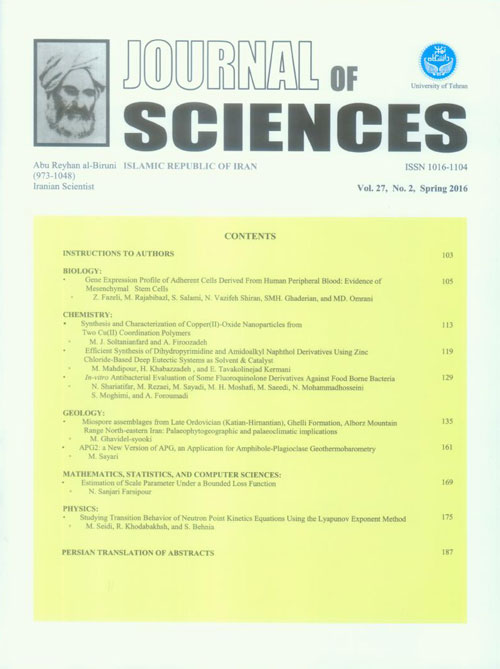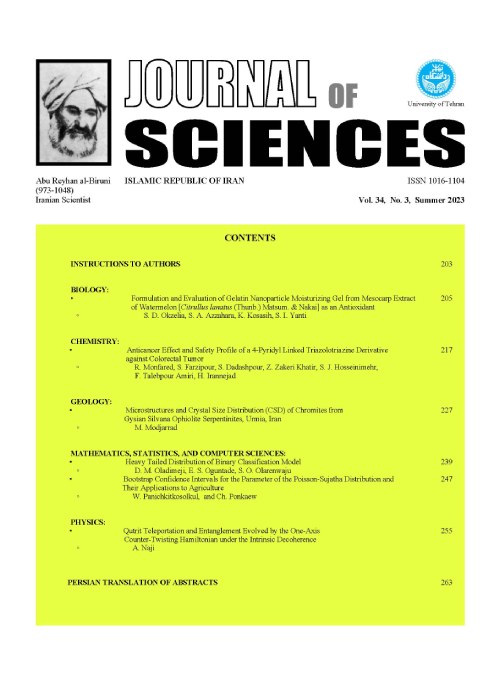فهرست مطالب

Journal of Sciences, Islamic Republic of Iran
Volume:27 Issue: 2, Spring 2016
- تاریخ انتشار: 1395/01/22
- تعداد عناوین: 8
-
-
صفحات 169-173
-
Pages 105-112Mesenchymal stem cells (MSCs) provide a novel option in cellular therapy and tissue engineering. Recent studies indicated that it is possible to obtain MSCs from peripheral blood by attachment ability to plastic surface. To evaluate adherent cells derived from peripheral blood, their expression profile and surface markers were investigated. The results of RT-PCR indicated that these cells expressed MECP2, SLITRK2, SLITRK4 as well as the neuronal markers Nestin, β III tubulin, NFM, MAP2 and NSE. In the present study, a panel of surface markers were analysed by flow cytometry. These cells display a fibroblast like morphology as well as known sources of MSCs. The results obtained from immune-staining represented that these cells were negative for CD14, CD45, CD15 and CD24, whereas they were positive for CD29, CD44, CD105, CD73, CD166 and CD184. Our data indicated that the peripheral blood could be considered as a source of MSCs with high yield.Keywords: Mesenchymal stem cells, Neuronal markers, Expression profile, Immune, phenotyping
-
Pages 113-117CuO nano particles were obtained by calcination of nano-sized [Cu(C4H4O4)(bipy)(H2O)2].2H2O (1) and [Cu(22′-bipy)](C4H4O4)0.5(NO3)(H2O) (2) which are two Cu(II) coordination polymers. The two coordination polymers [Cu(C4H4O4)(bipy)(H2O)2].2H2O and [Cu(22′-bipy)](C4H4O4)0.5(NO3)(H2O) were synthesized and characterized by Fourier transform infrared spectra (FT-IR spectroscopy), thermal gravimetric (TGA) and differential thermal analyses (DTA). CuO nano particles were characterized by X-ray powder diffraction (XRD) and scanning electron microscopy (SEM).The two coordination polymers obtained possessed nano sizes.Keywords: Copper(II) Oxide, Nanoparticles, Coordination polymer, Calcination
-
Pages 119-127Dihydropyrimidine and amidoalkyl naphthol derivatives have been prepared efficiently in a one-pot synthesis using ZnCl2/urea and ZnCl2/acetamide deep eutectic systems as reaction medium and homogeneous catalyst. This method offers some advantages such as simple procedure, inexpensive solvent and catalyst and good yields of the final products in short reaction times. The use of non-toxic and environmentally benign catalyst and solvent system are the main remarkable features of this procedure.Keywords: Deep eutectic, 3, 4, dihydropyrimidine, Amidoalkylnaphthol, Homogeneous catalyst
-
Pages 129-133Food poisoning has been emerged as a worldwide health issue and related illness in both developed and developing countries confirms its significance as an important public health priority.In vitro antibacterialevaluationof nine fluoroquinolone derivatives against food borne bacteria including Gram-positive (Staphylococcus aureus) and Gram-negative (Salmonella enterica, Escherichia coli, Yersinia enterocolitica, Vibrio cholerae) organisms was developed using agar dilution technique and compared with ciprofloxacin and norfloxacin as reference drugs.Most compounds showed good activity against Gram-positive and the Gram-negative bacteria. All compounds were active against Staphylococcus aureus (MIC=3.12-6.12µg/mL) and compounds 1a, 1c-e, 2a, and 3c(MIC=3.12µg/mL) exhibited excellent antibacterial activity in comparison to ciprofloxacin and norfloxacin (MIC=6.25µg/mL). Fluoroquinolone derivatives exhibited good activity against food borne bacteria and are appropriate candidates for food poisoning prevention.Keywords: Antibacterial evaluation, Fluoroquinolone, Food borne bacteria
-
Pages 135-159Well-preserved miospore assemblages are recorded from the Late Ordovician (Katian-Hirnantian), Ghelli Formation in Pelmis-gorge at the north-eastern Alborz Mountain The palynomorphs were extracted from siliciclastic deposits which are well-dated by using of marine palynomorphs (acritarchs and chitinozoans). The encountered miospore assemblages consist of 14 genera (28 species: 26 cryptospores and 2 trilete spores). Six new cryptospore taxa are described: Rimosotetras punctata, Rimosotetras granulata, Dyadospora asymmetrica, Dyadospora verrucata, Segestrespora iranense and Imperfectotriletes persianense. The present findings contribute to improving knowledge of origin and onset of development of vegetative cover during the Late Ordovician. The recovery of diverse and abundant cryptospores in the Late Ordovician (Katian-Hirnantian) Ghelli Formation are probably related to increasing input of land-derived sediments during the global sea-level fall linked to the Late Ordovician glaciation, and tolerance of the primitive land plants in a wide range of climatic conditions. These miospore taxa were produced by earliest primitive land plants which probably grew close to the shoreline and washed in from the adjacent areas and produced high amount of miospores. The associated marine palynomorphs consist of acritarchs (13 genera and 18 species), chitinozoans (9 genera and 10 species), prasinophycean algae, scolecodonts and graptolite remains which are not discussed in detail herein. The established chitinozoan biozones of this part of Palaeozoic sequences are Armoricochitina nigerica, Ancyrochitina merga, Tanuchitina elongata and Spinachitina oulebsiri, suggesting the Late Ordovician (Katian-Hirnantian). These chitinozoan biozones are well-known only in peri-Gondwanan Domain, indicating that the study area has been part of this palaeo-continent during the Late Ordovician.Keywords: Miospores, Late Ordovician, Palaeo, biogeography, Palaeo, climatology, Alborz Mountain Ranges
-
Pages 161-167APG2 is a computer application designed for amphibole-plagioclase geothermobarometry. It is the first updated version of APG and supports 4 thermometer models and 6 barometer models involving either amphibole-plagioclase or amphibole only. APG2 has capability to integrate all 4 thermometer models with 6 barometer models and produce 24 different states which user can export them all at once to an Excel table. APG2 works in both graphical and analytical way. APG2 is also able to calculate the H2O content and Oxygen fugacity (logfO2) of magma hosting amphiboles.Keywords: APG2 application, Amphibole, Plagioclase, Geothermobarometry
-
Pages 169-173The quadratic loss function has been used by decision-theoretic statisticians and economists for many years. In this paper the estimation of scale parameter under a bounded loss function, which is adequate for assessing quality and quality improvement, is considered with restriction to the principles of invariance and risk unbiasedness. An implicit form of minimum risk scale equivariant estimator and Bayes estimators are obtained. Fishers problem of the Nile as an example is included.Keywords: Best invariant estimator, Bayes estimator, Scale parameter, Bounded loss function, Fisher's problem of the Nile
-
Pages 175-186The neutron density is one of the most important dynamical parameters in a reactor. It is directly related to the control and stability of the reactor power. Any change in applied reactivity and some of dynamical parameters in the reactor causes a change in the neutron density. Lyapunov exponent method is a powerful tool for investigating the range of stability and the transient behavior of the reactor power. In contrast to the other linear stability methods, this method can be used for large perturbations and is not needed to construct Lyapunov function. In this work, the range of stability using Lyapunov exponent method is evaluated for neutron point kinetics equations with six-groups delayed neutrons. Here, effects of four set of applications, namely, step, ramp, sinusoidal, and temperature feedback reactivities on power reactor were investigated with Lyapunov exponent method. The results of qualitative analysis were compared with traditional methods and were in good agreement with other works.Keywords: Temperature feedback, Neutron density, Delayed neutron, Lyapunov exponent


